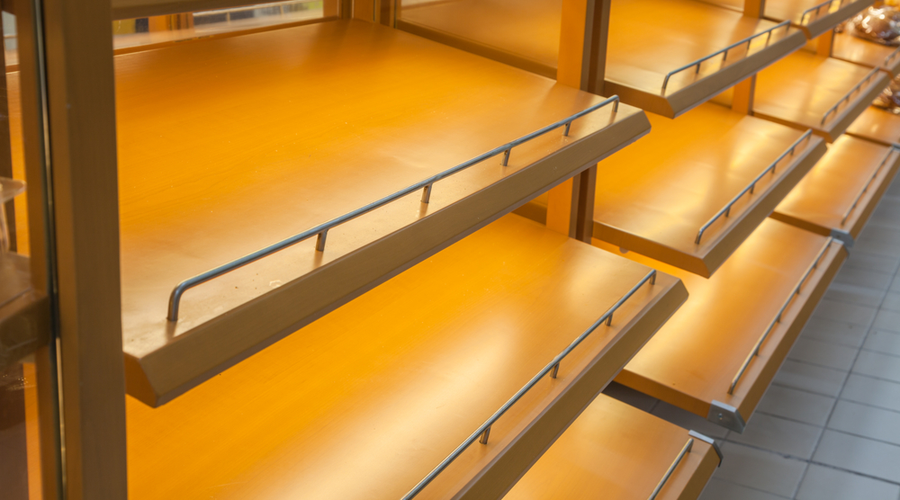When designing your pharmacy space, shelving might seem like a utilitarian choice: shelves do the simple job of holding up your merchandise. But your shelving can affect everything from how patients move throughout the store and interact with merchandise to how they perceive your pharmacy.
“The design of your retail shelving can have a significant impact on revenue,” said Steven DiOrio, marketing manager for Storflex Holdings, a retail store fixture manufacturer. With proper shelving and store design, you can create a friendlier shopping experience for your patients by improving the organization of your front end and enhancing the visibility of your merchandise.
Shelving isn’t just a matter of picking out some gondolas and end caps and putting your products on them. It is an extension of merchandising, helping you arrange your products in a way that makes them more appealing to patients. “Pharmacists must develop a strategic design centered around merchandising,” said DiOrio. “A terrific way to look at it is by taking each three-foot or four-foot section and developing a plan for each area.”
How you display your products affects patients’ perception. Not every item in your pharmacy will look great on a shelf. In your oral care section, for example, toothbrushes won’t be appealing if they are scattered on a shelf. Instead, achieve a cleaner look by displaying toothbrushes on peg hooks hanging from slatwall. On the other hand, toothpaste should be displayed on shelves only, so that patients can clearly see all the diverse options your pharmacy carries.
One of most important shelving units in your store is the end cap, which needs strategic arrangement to maximize value. “Most retailers think that end caps should be for your most popular products,” DiOrio said. But in reality, they are a chance to increase exposure to your most profitable products. “When designing a store with the goal of boosting profits, you want to merchandise your highest-profit margin items on those end unit displays.”
Creating a floor plan
Your shelving unit choices influence your floor plan, which dictates how patients move around your pharmacy. Typically, the pharmacy department is at the back of the store because it’s most people’s ultimate destination. Creating retail displays that encourage people to browse on the way to the pharmacy counter increases the chances they will add something to their cart. “When creating a floor plan, the goal is to increase sales of impulse items,” DiOrio said.
Most of the shelving in the middle of the floor will be gondolas, which are double-sided islands. Gondolas can display a wide variety of merchandise and can be strategically placed to encourage flow through the pharmacy in a specific direction. To encourage impulse buys, DiOrio recommends “prominently featuring end cap displays and other free-standing displays around the sales counter,” in addition to standard gondolas.
By placing your retail checkout counter at the front of the store, patients will have another opportunity to browse on the way out. But they might take a different route, so be sure to consider the shelving at the perimeter of your store, as well. Wall units can be used in conjunction with lighted canopies to draw patients in.
DiOrio noted that pharmacy owners should be aware of local laws when creating a floor plan because every state has different requirements when it comes to the spacing between aisles.
Form and function
Pharmacy shelves should be attractive enough to create a welcoming atmosphere, but you should never prioritize aesthetics over function. A few simple investments can add some flair to your shelving.
“If your pharmacy is in a high-end geographic location or you want to impress your customers, gondola shelving units featuring slatwall panels with a beautiful wood-tone finish won’t hurt or sacrifice the merchandising functionality business owners require,” DiOrio said. Another budget-friendly option is to add mica panels on your end cap displays. Adding a wooden top to your gondola shelves can both improve the appearance and create more space for merchandise that lands right at patients’ eye level.
Show off some of your pharmacy’s unique flair by incorporating the colors of your pharmacy branding into the shelving or adding eye-catching signage or decor.
The good news is that once you’ve settled on the right shelving, you can keep it that way for a long time. DiOrio recommended sprucing up your displays every five to seven years. In the interim, focus on keeping your shelves clean and tidy. “Many customers view pharmacies as an extension of a medical facility. Therefore, pharmacists must keep their stores as clean as possible, including the store fixture displays and retail sales counter,” he said.
Shelving faux pas
High-quality shelving can encourage people to shop more, but low-quality shelving will work against you. DiOrio emphasizes investing in good shelving as a customer relations strategy. With well-maintained shelving, you will create a positive impression as soon as patients walk into the pharmacy.
When planning a remodel, shelving should be one of your first priorities. Set the budget for shelving at the very beginning of the process so that you don’t get to the end and realize you can’t afford the shelving that works best for your store.
Worn or cheap-looking shelving will negatively color patients’ impression of your pharmacy. If a shelf is falling apart or poorly maintained, patients might subconsciously worry about the quality of the merchandise displayed on those shelves. Look out for chipping paint, sagging shelves, or cracks in your shelving and take quick action to repair or replace them.
Shoddy shelving can also pose a physical danger to your patients. If shelves aren’t sturdy, they could fall over or cause patients to trip. Aisles that aren’t wide enough can create accessibility problems for patients using mobility aids. Walk through your front end periodically to examine shelving and identify any potential hazards or age related deterioration.
Choosing the right gondola shelving
Gondola shelving is the most versatile option for showcasing your pharmacy’s front-end merchandise. You can mix and match pieces to create the perfect setup based on the products you sell.
Here’s what to consider before investing in new gondola shelves.
Size
Consider the size of your pharmacy and how patients move around the fixtures. If shelves are too big, your pharmacy will feel cluttered and crowded. If they are too small, you miss out on merchandising opportunities. Also reference local laws regarding aisle width.
Material
Metal shelving is more affordable and easier to keep clean. It can also be more versatile, allowing you to change shelf spacing and add features like hooks for hanging merchandise. Wood shelving is pricier, but can give your pharmacy a high-end feel. Wood shelves can also be custom fit to your space.
Accessories
Think about what will be displayed on and around your gondola shelving unit. Will the products benefit from additional undershelf lighting? Should the products be hung on hooks rather than set on a shelf? Will you add an end-cap display for cross-merchandising?
Style
Your shelving should complement the rest of the pharmacy’s look and feel. Customize the steel colors to coordinate with your pharmacy branding, or upgrade to a wood-toned pegboard or slatwall. Also consider how you will incorporate signage into your shelves.
Sources: Storflex Holdings, Shelving Design Systems
From the Magazine
This article was published in our quarterly print magazine, which covers relevant topics in greater depth featuring leading experts in the industry. Subscribe to receive the quarterly print issue in your mailbox. All registered independent pharmacies in the U.S. are eligible to receive a free subscription.
More articles from the December 2021 issue:
- Artificial Intelligence: Will Machine Learning Revolutionize Retail Pharmacy?
- Pharmacy Relief Agencies: How to Get Through Staff Shortages
- Risk Management Strategies for Small Businesses
- This Community Pharmacy Personalizes Patient Care Down to DNA
- National Retail Trend: Creating Your Own Brand of OTC Products
- Best Practices for Front-End Pharmacy Shelving
- Mental Health First Aid: Why Every Pharmacist Should Take the Training
A Member-Owned Company Serving Independent Pharmacies
PBA Health is dedicated to helping independent pharmacies reach their full potential on the buy-side of their business. Founded and run by pharmacists, PBA Health serves independent pharmacies with group purchasing services, wholesaler contract negotiations, proprietary purchasing tools, and more.
An HDA member, PBA Health operates its own NABP-accredited warehouse with more than 6,000 SKUs, including brands, generics, narcotics CII-CV, cold-storage products, and over-the-counter (OTC) products — offering the lowest prices in the secondary market.












